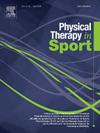Blood flow restriction training compared to conventional training in people with knee pain: a systematic review with meta-analysis
IF 2.2
3区 医学
Q1 REHABILITATION
引用次数: 0
Abstract
Objective
Evaluate the efficacy of blood flow restriction training (BFRT) in people with knee conditions.
Methods
We searched Medline, Web of Science, and Sport DISCUS from inception until October 2023, seeking randomised controlled trials (RCTs) involving participants with any knee condition and BFRT in at least one intervention arm. We used a random-effects model meta-analysis to pool methodologically homogeneous data and the Grading of Recommendations, Assessment, Development, and Evaluations approach to categorise certainty of evidence.
Results
15 RCTs involving 418 participants were eligible, investigating people post-anterior cruciate ligament reconstruction (n = 7) and cartilage surgery (n = 2), or with knee osteoarthritis (n = 3) and patellofemoral pain (n = 3). There is very low certainty evidence that adding BFRT to resistance training is superior to resistance training for pain outcomes (small SMD 0.47, 95 % CI 0.09, 0.85). There is very low certainty evidence that adding BFRT to resistance training is equivalent to resistance training for function and strength outcomes.
Conclusions
BFRT offers a significant effect on short-term pain that is of questionable clinical relevance, and no significant effects on function or quadriceps strength. Future high-quality RCTs are required to appropriately explore clinical efficacy, and clinicians should exercise caution in offering BFRT to people with knee conditions.
限制血流训练与常规训练在膝关节疼痛患者中的比较:一项荟萃分析的系统综述
目的评价血流量限制训练(BFRT)对膝关节疾病患者的治疗效果。方法:我们检索了Medline、Web of Science和Sport DISCUS从成立到2023年10月,寻找随机对照试验(RCTs),涉及至少一个干预组中任何膝关节状况和BFRT的参与者。我们使用随机效应模型荟萃分析来汇集方法学上同质的数据,并使用推荐、评估、发展和评估分级方法来对证据的确定性进行分类。结果15项随机对照试验纳入418名受试者,调查了前交叉韧带重建(n = 7)和软骨手术(n = 2),或膝关节骨关节炎(n = 3)和髌骨股痛(n = 3)患者。有非常低的确定性证据表明,在阻力训练中加入BFRT比阻力训练更能改善疼痛结局(小SMD 0.47, 95% CI 0.09, 0.85)。有非常低的确定性证据表明,在阻力训练中加入BFRT与在功能和力量方面的阻力训练是等同的。结论sbfrt对短期疼痛有显著影响,但临床相关性尚存疑问,对功能或股四头肌力量无显著影响。未来需要高质量的随机对照试验来适当地探索临床疗效,临床医生在为膝关节疾病患者提供BFRT时应谨慎行事。
本文章由计算机程序翻译,如有差异,请以英文原文为准。
求助全文
约1分钟内获得全文
求助全文
来源期刊

Physical Therapy in Sport
医学-康复医学
CiteScore
4.50
自引率
8.30%
发文量
125
审稿时长
39 days
期刊介绍:
Physical Therapy in Sport is an international peer-reviewed journal that provides a forum for the publication of research and clinical practice material relevant to the healthcare professions involved in sports and exercise medicine, and rehabilitation. The journal publishes material that is indispensable for day-to-day practice and continuing professional development. Physical Therapy in Sport covers topics dealing with the diagnosis, treatment, and prevention of injuries, as well as more general areas of sports and exercise medicine and related sports science.
The journal publishes original research, case studies, reviews, masterclasses, papers on clinical approaches, and book reviews, as well as occasional reports from conferences. Papers are double-blind peer-reviewed by our international advisory board and other international experts, and submissions from a broad range of disciplines are actively encouraged.
 求助内容:
求助内容: 应助结果提醒方式:
应助结果提醒方式:


